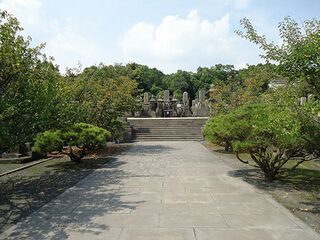Difference between revisions of "Nanshu Cemetery"
(Created page with "right|thumb|320px|The view of the cemetery as one approaches from the entrance *''Established: 1877'' *''Japanese'': 南洲墓地 ''(nanshuu bochi...") |
(No difference)
|
Revision as of 18:25, 12 February 2015
- Established: 1877
- Japanese: 南洲墓地 (nanshuu bochi)
The Nanshû Cemetery in Kagoshima is the final burial place for Saigô Takamori and 2,022 other men who died in the 1877 Satsuma Rebellion fighting against the Imperial Japanese Army. It is located on the former grounds of the Buddhist temple Jôkômyô-ji, up on a hill, overlooking a major avenue which formerly housed a number of Shimazu clan mansions.
Following Saigô's death at the battle of Shiroyama, Kagoshima prefecture governor Iwamura Michitoshi had him and forty of his men buried on the former grounds of Jôkômyô-ji, a temple which had been destroyed in the 1863 bombardment of Kagoshima by the British Royal Navy, and abolished in the haibutsu kishaku anti-Buddhism policies of the first years of the Meiji period. Two years later, in 1879, the remains of a number of Saigô's men who had initially been buried elsewhere were relocated here, and six years after that, remains of others who fell in the rebellion were relocated from graves in neighboring prefectures.
Saigô's grave stands in the center of the cemetery, with those of Kirino Toshiaki, Beppu Kanenaga, Katsura Hisatake, Murata Shinpachi, Shinohara Kunimoto, and Ôyama Tsunayoshi Kakunosuke immediately nearby, along a row. These, along with many of the other graves today have modern signs identifying the figures buried there. At the front of the cemetery stands a stone monument to governor Iwamura, along with a stone inscribed with an epitaph for Saigô written by Katsu Kaishû, and a stone lantern gifted to the site by the City of Tokyo in 1939, in gratitude for the bloodless way in which Edo castle was taken during the Meiji Restoration. Another stone, a gift to the city from Changsha, stands as a monument to Huang Xing, a major figure in the 1911 Xinhai Revolution, described here as the "Saigô Takamori of China." A bamboo garden directly behind the cemetery was established in memory of Satsuma han daimyô Shimazu Yoshitaka (r. 1704-1721).
A building was constructed on the site in 1879 to help commemorate the war dead; in 1922 it was officially designated as Nanshû Shrine (Nanshû jinja), enshrining the spirit of Saigô Takamori. Jôkômyô-ji has been reestablished and stands immediately neighboring the cemetery today, along with the Saigô Nanshû Memorial Hall (Saigô Nanshû kenshôkan) museum/archives.
Selected Burials
- Saigô Takamori
- Beppu Kanenaga
- Fuchibe Takateru (Gunpei)
- Henmi Jûrôta
- Hirano Shôsuke
- Ijichi Suekichi
- Ikeda Kôtarô
- Ikenoue Sadakata
- Katsura Hisatake
- Kawagoe Yôtarô
- Kawashô Yoshinori
- Kirino Toshiaki
- The Kodama brothers, Sanenao, Sanekiyo, Saneyasu, Sanetake, and Hikokichi
- Masuda Eitarô and 21 other men from Nakatsu, Oita prefecture
- Morikawa Masakazu
- Murata Shinpachi
- Nagayama Morihiro
- Nakamura Josuke
- Niiro Sôjirô
- Ôgura Sôkurô Tomochika
- Ôyama Tsunayoshi Kakunosuke
- Saigô Kôhei
- Sakakibara Masaharu
- Shimazu Keijirô
- Shinohara Kunimoto
- Tanegashima Hikonojô
- Tomo Kaneyuki
- Yamanoda Kazusuke
References
- Plaques on-site.
